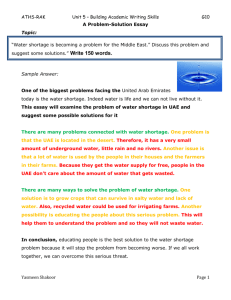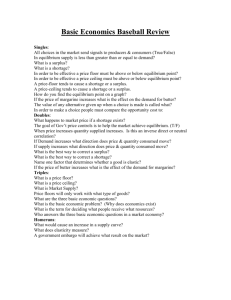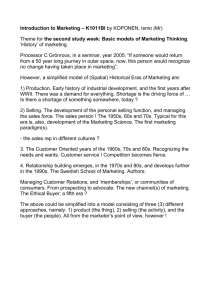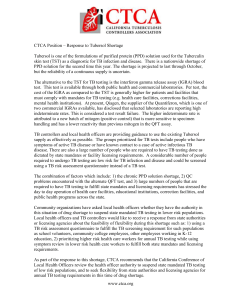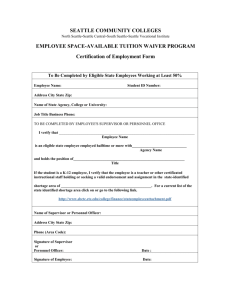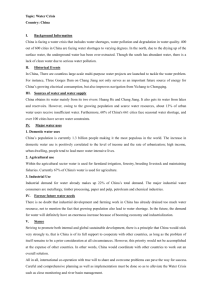Drug Shortage Prevention and Response Plan
advertisement
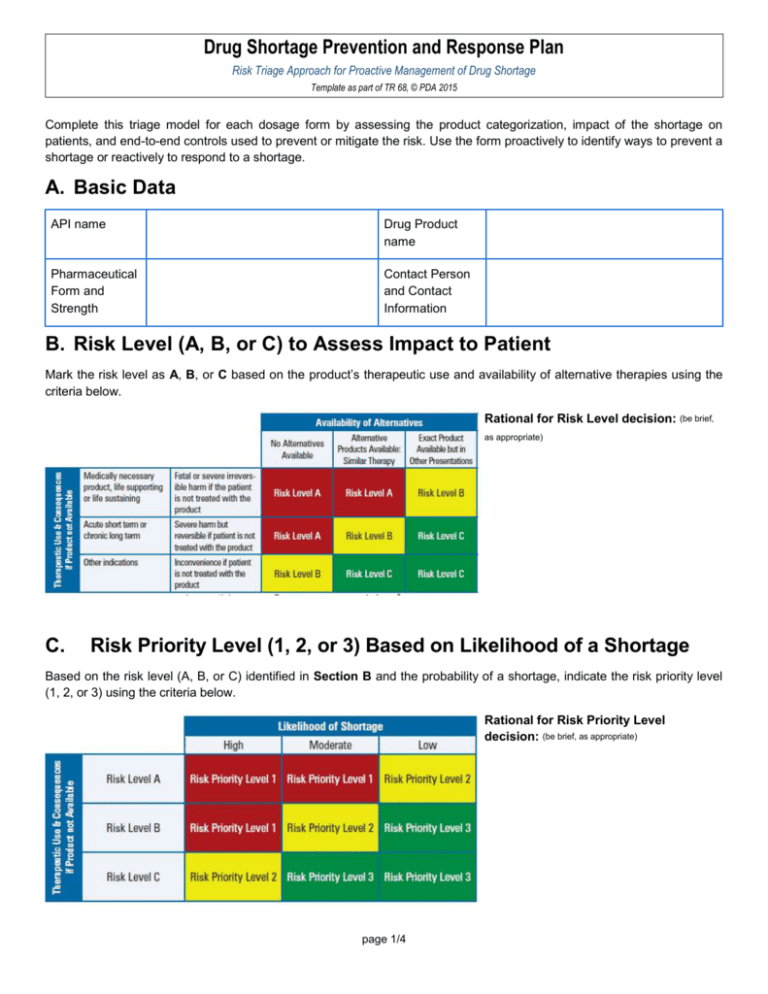
Drug Shortage Prevention and Response Plan Risk Triage Approach for Proactive Management of Drug Shortage Template as part of TR 68, © PDA 2015 Complete this triage model for each dosage form by assessing the product categorization, impact of the shortage on patients, and end-to-end controls used to prevent or mitigate the risk. Use the form proactively to identify ways to prevent a shortage or reactively to respond to a shortage. A. Basic Data API name Drug Product name Pharmaceutical Form and Strength Contact Person and Contact Information B. Risk Level (A, B, or C) to Assess Impact to Patient Mark the risk level as A, B, or C based on the product’s therapeutic use and availability of alternative therapies using the criteria below. Rational for Risk Level decision: (be brief, as appropriate) C. Risk Priority Level (1, 2, or 3) Based on Likelihood of a Shortage Based on the risk level (A, B, or C) identified in Section B and the probability of a shortage, indicate the risk priority level (1, 2, or 3) using the criteria below. Rational for Risk Priority Level decision: (be brief, as appropriate) page 1/4 Drug Shortage Prevention and Response Plan Risk Triage Approach for Proactive Management of Drug Shortage Template as part of TR 68, © PDA 2015 D. Risk-Control Activities for a Proactive Drug Shortage Prevention Plan Based on the potential risk priority level (1, 2, or 3), describe suggested controls to be established, communication plan (in the event of a shortage), and other considerations. Risk Priority Level Suggested Controls (Examples) Risk priority level 1 Risk priority level 2 Risk priority level 3 Communication Plan (in the Event of a Shortage) Controls to be Established Other Considerations Appropriate inventory and safety stock management Multisite sourcing with higher manufacturing capacity reserves Supplier management controls Supply chain/transportation line security, business continuity, and communication plan Multi-site sourcing Value stream mapping Proactive inventory management Process capability and robustness exercised (with quality metrics) Generally accepted risk level page 2/4 Drug Shortage Prevention and Response Plan Risk Triage Approach for Proactive Management of Drug Shortage Template as part of TR 68, © PDA 2015 E. Risk-Control Activities for a Reactive Drug Shortage Response Plan Develop a reactive drug shortage response plan (and discuss the plan as needed with the relevant health authorities) for implementation in the event of a drug shortage. Identify the reason(s) for the shortage or stock depletion (check all that apply): Commercial issues (e.g., unexpected product demand) Manufacturing issues (e.g., manufacturing difficulties) Supply chain issues (e.g., low availability of active substance or components, shipping delays) GMP/GDP issues that do not affect batches already released to the market GMP issues that could affect batches already released to the market Quality defect issues that have led to a product recall or a supply restriction Unexpected delays in regulatory approval (e.g., for a marketing authorization renewal, variation, transfer) Other issues 1. Assess risks to patients per Section B (attach risk assessment) from the shortage, including expected duration of the situation and patient groups likely to be affected by the shortage (e.g., neonates, people with diabetes). 2. Create (and attach) a short-term action plan based on Section D above and/or discussions with relevant health authorities to include actions that can be taken to address the shortage in the near-term (e.g., when alternative therapies are available) and relevant rationale for the identified action plan. 3. Execute the communication plan based on the shortage’s characteristics. 4. Create (and attach) a longer-term action plan based on Section D above to include actions, relevant rationale and timelines needed to return the product supply to normal. page 3/4 Drug Shortage Prevention and Response Plan Risk Triage Approach for Proactive Management of Drug Shortage Template as part of TR 68, © PDA 2015 F. Risk Reviews and Updates Identify the triggers for reviewing and updating the Drug Shortage Prevention and Response Plan. Include relevant rationale for the identified triggers Check the trigger(s) that will drive reviews and revisions of the Drug Shortage Prevention and Response Plan: New product indication New market approval Approval of a new alternative or unlicensed product Shortage of an alternate product New risks to product quality or availability Shutdown of a facility or withdrawal of GMP certificate Inventory or safety stock levels below target level Increase in product usage volumes Other (provide details) Rational for Identified Triggers: (be brief, as appropriate): G. Approvals Required Person Responsible QA Decision Maker Senior Management Function page 4/4
